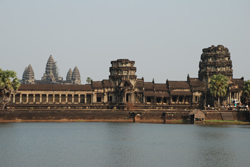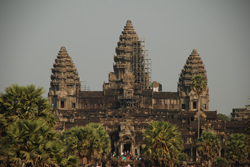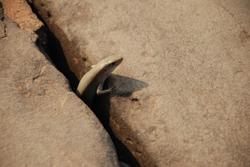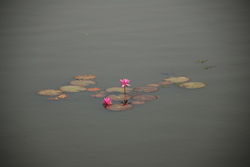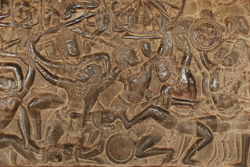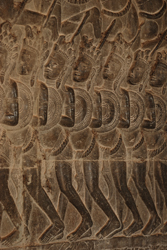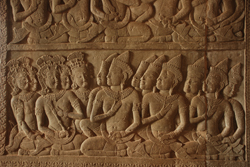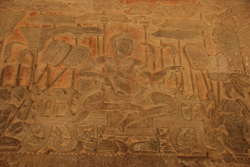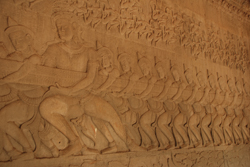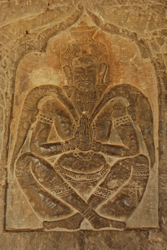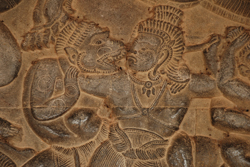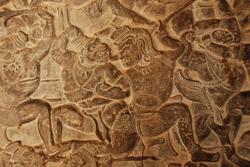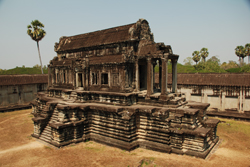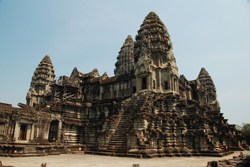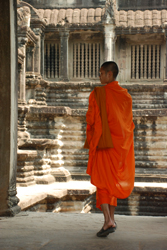Angkor: Visiting Angkor Wat
4 February, 2009, 02:39 am in "Cambodia"
Angkor Wat did not look crowded, unlike the other times we biked by. So we went in. The reason it wasn't crowded was we were there at 10 and the tours go either in the morning for sunrise or afternoon because the light is better. The view was a little hazy since the sun was behind it-- but Rowshan had taken view photos yesterday evening. The important thing was no crowds.
Angkor Wat was designed to take you from the world of men to the realm of the gods. The design is based on Hindu mythology and represents Mt. Meru, the home of the gods. Mt. Meru is a 5 peaked mountain (represented by the towers) which is the center of the universe. It is surrounded by 6 mountain chains and oceans. Although Angkor Wat's mountain doesn't have 6 mountain chains it does have several walled galleries surrounding it and a large moat.
Angkor Wat was designed to take you from the world of men to the realm of the gods. The design is based on Hindu mythology and represents Mt. Meru, the home of the gods. Mt. Meru is a 5 peaked mountain (represented by the towers) which is the center of the universe. It is surrounded by 6 mountain chains and oceans. Although Angkor Wat's mountain doesn't have 6 mountain chains it does have several walled galleries surrounding it and a large moat.
Walking down the long wide bridge of huge flag stones to the gate and then another long path lined with naga balustrades to the wat gives one the feeling of journeying to another realm. In the morning, fuchsia lotuses bloom in the reflecting pools in front of the wat though they disappear as the sun gets hotter.
The first gallery layer which makes up the outer walls of the wat takes the visitor on another journey through history and legend, guided by bas relief murals carved into blocks of sandstone.
The South-Western wall, the first we walked along, was the overwhelming chaos of the battle of Kurukshetra-- a very large part of the Mahabarata, an Indian (Hindu) epic popular in Cambodia until it faded with the decline of Angkor. The wall was covered with layers of people on foot, and in chariots fighting. All seemed to have slightly different positions even when they were in lines.
The South-Western wall, the first we walked along, was the overwhelming chaos of the battle of Kurukshetra-- a very large part of the Mahabarata, an Indian (Hindu) epic popular in Cambodia until it faded with the decline of Angkor. The wall was covered with layers of people on foot, and in chariots fighting. All seemed to have slightly different positions even when they were in lines.
After the chaos and motion of the figures on the battle wall, we entered a corner chamber which was suddenly calm. The walls had all these figures calmly sitting-- even cows and horses. The ceilings of this corner were corbeled vaults about 30 feet high. Angkor Wat is massive. Just th outer gallery is this tall (and set about 20 feet above the ground) The progressive layers are higher.
The West portion of the Southern wall depicted historical events related to the reign of King Suryavarman II, the founder of Angkor. We found ourselves walking with an orderly procession of carved people on the lower section of the mural bringing tribute. The 2nd level of the mural had seated soldiers. Behind the procession were forests of trees, with each leaf depicted, animals and birds. The mural depicted patterns in clothing, different head dresses, and jewelry. Towards the center was the king surrounded by courtiers and servants. Then the scene went through a transition and became a battle scene with soldiers and elephants. The transition also was one where 2 levels (upper and lower) became just one scene. This was done by having the soldiers on the top level march down a “hill” from top to lower level making the scene into just one level.
The West portion of the Southern wall depicted historical events related to the reign of King Suryavarman II, the founder of Angkor. We found ourselves walking with an orderly procession of carved people on the lower section of the mural bringing tribute. The 2nd level of the mural had seated soldiers. Behind the procession were forests of trees, with each leaf depicted, animals and birds. The mural depicted patterns in clothing, different head dresses, and jewelry. Towards the center was the king surrounded by courtiers and servants. Then the scene went through a transition and became a battle scene with soldiers and elephants. The transition also was one where 2 levels (upper and lower) became just one scene. This was done by having the soldiers on the top level march down a “hill” from top to lower level making the scene into just one level.
The Eastern section of the South wall was a journey through 37 heavens and 32 hells from the Indian tradition. On another wall, a portion of the “Churning of the Sea of Milk” mural was being restored. Lots of the main temples of Angkor are in the process of restoration or reconstruction by international organizations from Japan, German, France and others.
The North section of the East wall was carved in the 16th century and represented scenes from the Indian epic Harivamsha in which Vishnu fights and defeats all the demons. Vishnu was surrounded by the chaos of demons he defeats. The next wall showed more battles of the the gods, ending with a series of caves with meditating figures inside.
The last wall we looked at depicted a battle from the Ramayana in which Rama, an avatar of Vishnu, battled King Ravana's army. Rama was aided by Hanuman and his army of monkeys. The monkeys often were attacking by biting peoples' faces.
From there we progressed to the inner levels which were another 20 feet higher than the outer gallery-- raised on a base of rock and earth. Angkor Wat was surprisingly quiet. Everyone comes for dawn or dusk but most of what you look at is sheltered inside so it really doesn't matter what time you visit. We were grateful we visited when we did. The mid day heat was broken by breezes whispering along the cool stone corridors and the shady vaults.
The inner sanctuary, up another 2 levels was closed for restoration. The towers have carvings on the exterior and lotus petals on top. The eroded sandstone they are made of gives them a slightly melted appearance. A myna bird called, seemingly mimicking a monkey, from one of the towers. The inner sanctuary reminded me of a giant sand castle.
In the level below was a standing Buddha. A group of orange-clad monks walked in and soon everyone was photographing them. The monks seemed to be very patient.
Comments
- Comments
Powered by My Blog 1.69. Copyright 2003-2006 FuzzyMonkey.net.
Created by the scripting wizards at FuzzyMonkey.net..
(Code modified by Rowshan Dowlatabadi)
Created by the scripting wizards at FuzzyMonkey.net..
(Code modified by Rowshan Dowlatabadi)


